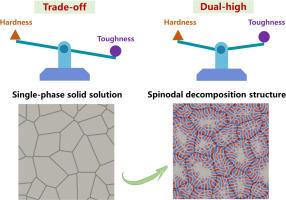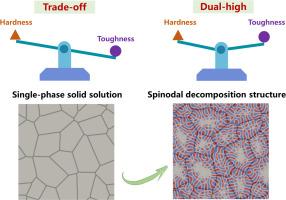Insight of the microstructure evolution and performance enhancement of spinodal decomposition in (Ti, Zr)C composite carbide ceramics: Multiscale simulation and experimental investigation
IF 8.3
1区 材料科学
Q1 MATERIALS SCIENCE, MULTIDISCIPLINARY
引用次数: 0
Abstract
Traditional carbide ceramics face a sharp trade-off between hardness and toughness, leading to a significantly reduced lifespan under harsh service conditions like wear, impact, corrosion, and high temperatures. The spinodal decomposition leads to the formation of nano-lamellar structures, serving to refine grain sizes, thus paving the way to simultaneously improve the hardness and toughness of composite carbide ceramics. A wide range of composite carbides can be prepared, but their complex microstructure evolution during aging makes performance optimization extremely challenging. In this work, a strategy by combining the multiscale simulations and experiments is proposed to systematically study the influence of the composition and process on the spinodal decomposition structure and performance. Taking (Ti, Zr)C carbide ceramics as a representative example, three distinct compositions of (Ti, Zr)C solid solutions were successfully synthesized via a sol-gel combined with spark plasma sintering method at 1800 °C, guided by thermodynamic calculations. The influence of aging temperature and duration on spinodal decomposition microstructure evolution in (Ti, Zr)C carbide ceramics was studied by integrating phase-field simulations and first-principles calculations with key experimental observations. After spinodal decomposition, numerous nanoscale nodular structures form, accompanied by the generation of dislocations, leading to a significant improvement in both hardness and toughness of the composite carbides. After aging at 1300 °C for 3 h, the composite carbides achieved peak hardness at 2436 HV, accompanied by a fracture toughness of 3.24 MPa·m1/2. This research provides a scientific approach to improving the hardness and toughness of carbide ceramics through spinodal decomposition, offering essential theoretical foundations for microstructural control and synergistic optimization of performance in innovative carbide ceramics.


洞察(Ti, Zr)C 复合碳化物陶瓷中的微观结构演变和旋光分解的性能提升:多尺度模拟和实验研究
传统的硬质合金陶瓷在硬度和韧性之间存在着巨大的权衡,导致其在磨损、冲击、腐蚀和高温等恶劣工况下的使用寿命大大缩短。旋光分解可形成纳米层状结构,细化晶粒尺寸,从而为同时提高复合硬质合金陶瓷的硬度和韧性铺平了道路。虽然可以制备多种复合碳化物,但它们在老化过程中复杂的微观结构演变使得性能优化极具挑战性。本研究提出了一种结合多尺度模拟和实验的策略,以系统研究成分和工艺对旋压分解结构和性能的影响。以(Ti,Zr)C 碳化物陶瓷为例,在热力学计算的指导下,通过溶胶-凝胶结合火花等离子体烧结法在 1800°C 下成功合成了三种不同成分的(Ti,Zr)C 固溶体。通过将相场模拟和第一原理计算与关键的实验观察相结合,研究了老化温度和持续时间对(Ti,Zr)C 碳化物陶瓷中旋光分解微观结构演变的影响。在旋光分解后,形成了大量纳米级结节结构,并伴随着位错的产生,从而显著提高了复合碳化物的硬度和韧性。在 1300°C 下老化 3 小时后,复合碳化物的峰值硬度达到 2436 HV,断裂韧性达到 3.24 MPa-m1/2。这项研究为通过旋光分解提高硬质合金陶瓷的硬度和韧性提供了科学方法,为创新硬质合金陶瓷的微结构控制和性能协同优化提供了重要的理论基础。
本文章由计算机程序翻译,如有差异,请以英文原文为准。
求助全文
约1分钟内获得全文
求助全文
来源期刊

Acta Materialia
工程技术-材料科学:综合
CiteScore
16.10
自引率
8.50%
发文量
801
审稿时长
53 days
期刊介绍:
Acta Materialia serves as a platform for publishing full-length, original papers and commissioned overviews that contribute to a profound understanding of the correlation between the processing, structure, and properties of inorganic materials. The journal seeks papers with high impact potential or those that significantly propel the field forward. The scope includes the atomic and molecular arrangements, chemical and electronic structures, and microstructure of materials, focusing on their mechanical or functional behavior across all length scales, including nanostructures.
 求助内容:
求助内容: 应助结果提醒方式:
应助结果提醒方式:


